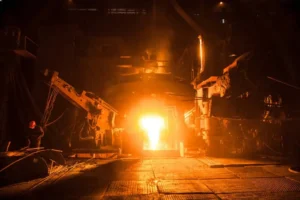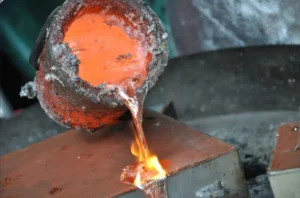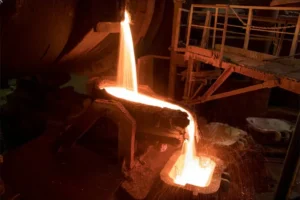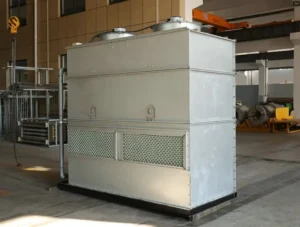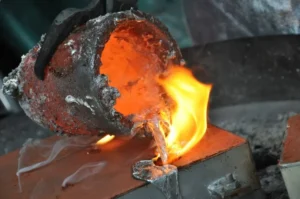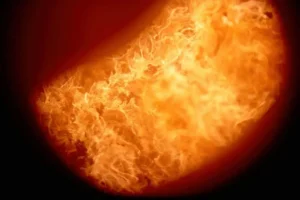Trong sản xuất công nghiệp, Lò cảm ứng là một thiết bị quan trọng để làm tan chảy kim loại, nhưng mức tiêu thụ năng lượng cao cũng đặt ra thách thức đáng kể trong việc kiểm soát chi phí và phát triển xanh. Bằng cách thực hiện một loạt các chiến lược hiệu quả, có thể cải thiện đáng kể hiệu suất năng lượng của lò cảm ứng, từ đó giảm chi phí sản xuất và lượng khí thải carbon. Năm lời khuyên thiết thực sau đây trình bày chi tiết cách giảm tiêu thụ năng lượng của lò cảm ứng một cách hiệu quả bằng cách tối ưu hóa hoạt động, cải thiện lớp lót lò, và hợp lý hóa kế hoạch sản xuất.
1. Tối ưu hóa quá trình chuẩn bị và sạc nguyên liệu
Chất lượng nạp của lò và phương pháp nạp ảnh hưởng trực tiếp đến hiệu suất nấu chảy và mức tiêu thụ điện. Quy trình chuẩn bị và nạp nguyên liệu được tối ưu hóa là bước đầu tiên hướng tới tiết kiệm năng lượng.
- Làm sạch và phân loại vật liệu sạc: Đảm bảo vật liệu kim loại đưa vào lò sạch sẽ, không rỉ sét, dầu, và tạp chất. Các chất gây ô nhiễm trên bề mặt điện tích không chỉ làm tăng mức tiêu thụ năng lượng mà còn ảnh hưởng đến chất lượng nóng chảy. Phân loại vật liệu dựa trên kích thước và mật độ, ưu tiên nặng, vật liệu có kích thước phù hợp để cải thiện hiệu quả ghép điện từ và rút ngắn thời gian nóng chảy.
- Làm nóng trước khi sạc: Sử dụng nhiệt thải từ thiết bị khác hoặc thiết bị gia nhiệt sơ bộ chuyên dụng để gia nhiệt sơ bộ vật liệu nạp trước khi chúng được thêm vào lò cảm ứng. Các nghiên cứu cho thấy rằng việc làm nóng trước điện tích đến vài trăm độ C có thể rút ngắn đáng kể chu kỳ nóng chảy và giảm mức tiêu thụ điện tổng thể.
- Phương pháp sạc khoa học: Tránh để lò dưới tải (giống như sử dụng một chiếc xe đẩy lớn để chở hàng nhỏ) và cũng tránh “nghẹt thở” lò bằng cách thêm quá nhiều vật liệu cùng một lúc. Cách tốt nhất là duy trì một “gót chân” kim loại nóng chảy trong lò và thêm vật liệu tích điện liên tục với số lượng nhỏ, đợt thường xuyên. Điều này giữ cho mức năng lượng luôn ở mức cao, đạt được sự tan chảy hiệu quả.
2. Tối ưu hóa thiết kế và bảo trì lớp lót lò
Là thành phần cốt lõi của lò cảm ứng, lựa chọn vật liệu của lớp lót, chất lượng lắp đặt, và bảo trì tiếp theo là rất quan trọng để đạt được hiệu quả năng lượng.
- Chọn vật liệu lót chất lượng cao: Lựa chọn vật liệu chịu lửa chất lượng cao có đặc tính cách nhiệt tốt và khả năng chống sốc nhiệt. Vật liệu lót cao cấp có thể giảm thất thoát nhiệt qua thành lò một cách hiệu quả, tập trung nhiều năng lượng hơn trong bồn tắm nóng chảy. Ví dụ, sử dụng vật liệu có thể rung khô hoặc vật liệu đúc có mật độ cao và độ dẫn nhiệt thấp.
- Kiểm soát độ dày lớp lót một cách thích hợp: Độ dày của lớp lót lò cần đạt được sự cân bằng giữa hiệu suất cách nhiệt và hiệu suất điện. Lớp lót quá dày sẽ tăng khả năng thất thoát nhiệt, trong khi lò quá mỏng có thể ảnh hưởng đến độ an toàn và giảm tuổi thọ của lò. Độ dày tối ưu cần được xác định dựa trên công suất của lò, yêu cầu hoạt động, và khuyến nghị của nhà sản xuất.
- Tiến hành kiểm tra thường xuyên và BẢO TRÌ: Thường xuyên kiểm tra lớp lót xem có bị xói mòn và nứt không. Bất kỳ hư hỏng nào đối với lớp lót sẽ dẫn đến tăng tổn thất nhiệt và thậm chí có thể gây ra sự cố an toàn. Sửa chữa kịp thời hoặc thay thế lớp lót một cách dứt khoát khi hết thời gian sử dụng là biện pháp cần thiết để duy trì hiệu suất cao của lò cảm ứng.
3. Sắp xếp sản xuất và lập kế hoạch hợp lý
Lập kế hoạch sản xuất khoa học có thể tối đa hóa thời gian làm việc hiệu quả của lò cảm ứng và giảm lãng phí năng lượng không cần thiết.
- Hoạt động liên tục và nóng chảy tập trung: Sắp xếp liên tục, hoạt động nấu chảy không bị gián đoạn bất cứ khi nào có thể. Lò nung cảm ứng tiêu thụ một lượng lớn năng lượng khi khởi động nguội để làm nóng thân lò. Hoạt động liên tục tránh lãng phí năng lượng do khởi động và tắt máy thường xuyên. Hợp nhất nhiều đơn đặt hàng lô nhỏ để nấu chảy tập trung để đảm bảo lò hoạt động ở mức hoặc gần hết công suất, tải tối ưu trong hầu hết thời gian.
- Giảm thiểu thời gian nhàn rỗi và thời gian chờ: Lên kế hoạch cẩn thận cho quy trình sản xuất để đảm bảo kim loại nóng chảy có thể được vận chuyển và sử dụng nhanh chóng sau khi nấu chảy xong. Giảm thiểu thời gian mở nắp lò và thời gian kim loại nóng chảy được giữ trong lò. Việc giữ lâu không chỉ tiêu tốn điện mà còn làm tăng độ hao mòn của lớp lót lò.
- Sử dụng giá điện cao điểm và thấp điểm: Đối với các vùng có giá điện theo thời gian sử dụng, các công ty nên sắp xếp hợp lý các ca sản xuất để tiến hành hoạt động nấu chảy trong giờ thấp điểm hoặc giữa giờ cao điểm khi giá điện thấp hơn. Mặc dù điều này không trực tiếp làm giảm lượng năng lượng vật lý tiêu thụ, nó có thể giảm đáng kể chi phí điện, từ đó nâng cao lợi ích kinh tế.
4. Kiểm soát chính xác nhiệt độ và công suất nóng chảy
Kiểm soát chính xác các thông số chính trong quá trình nấu chảy là phương tiện kỹ thuật quan trọng để đạt được mức tiết kiệm năng lượng.
- Tránh quá nóng quá mức: Đồng thời đảm bảo đáp ứng các yêu cầu về quá trình đúc, nhiệt độ khai thác của kim loại nóng chảy phải được kiểm soát chặt chẽ để tránh quá nóng không cần thiết. Cứ tăng nhiệt độ 10°C đối với một tấn kim loại nóng chảy sẽ tiêu tốn một lượng năng lượng bổ sung đáng kể. Sử dụng thiết bị đo nhiệt độ chính xác và thiết lập các tiêu chuẩn kiểm soát nhiệt độ nghiêm ngặt.
- Tối ưu hóa sức mạnh Đầu ra Đường cong: Điều chỉnh công suất đầu ra của lò cảm ứng theo các giai đoạn nóng chảy khác nhau (thời kỳ tan chảy, thời kỳ quá nhiệt, thời gian nắm giữ). Trong thời kỳ tan chảy, duy trì công suất cao nhất có thể để rút ngắn thời gian nóng chảy. Trong giai đoạn quá nhiệt và giữ, nên giảm công suất một cách hợp lý để giảm thiểu lãng phí năng lượng và giảm xói mòn lớp lót lò.
5. Tăng cường bảo trì thiết bị và đào tạo người vận hành
Tình trạng tốt của thiết bị và kỹ năng chuyên môn của người vận hành là nền tảng để đảm bảo các biện pháp tiết kiệm năng lượng được thực hiện hiệu quả..
- Thường xuyên bảo trì các Hệ thống điện: Giữ các bộ phận điện như cuộn dây cảm ứng, cáp làm mát bằng nước, và tụ điện sạch sẽ và trong tình trạng tốt. Kiểm tra, siết chặt tất cả các điểm đấu nối để giảm tổn thất điện trở. Đảm bảo hệ thống nước làm mát hoạt động tốt, vì nhiệt độ của cuộn dây cũng ảnh hưởng đến hiệu suất điện của nó.
- Đào tạo người vận hành: Cung cấp đào tạo vận hành tiết kiệm năng lượng có hệ thống cho người vận hành lò, nhờ đó họ hiểu đầy đủ tầm quan trọng của việc tiết kiệm năng lượng và nắm vững các kỹ thuật tiết kiệm khác nhau nêu trên. Người vận hành lành nghề có thể đưa ra phán đoán và điều chỉnh nhanh chóng, chính xác dựa trên sự thay đổi của điều kiện lò, từ đó đạt được sự tiết kiệm năng lượng liên tục trong sản xuất hàng ngày.
Bằng cách áp dụng toàn diện các kỹ thuật từ năm lĩnh vực này, các công ty có thể cải thiện một cách có hệ thống hiệu quả sử dụng năng lượng của lò nung cảm ứng của họ, đạt được lợi thế về chi phí trong một thị trường cạnh tranh, và góp phần phát triển bền vững.


